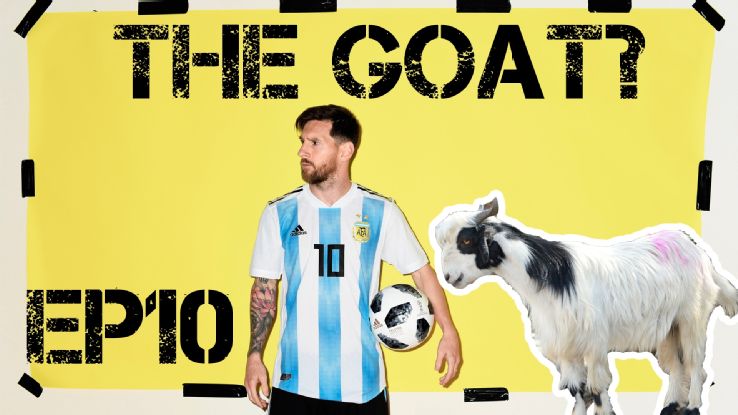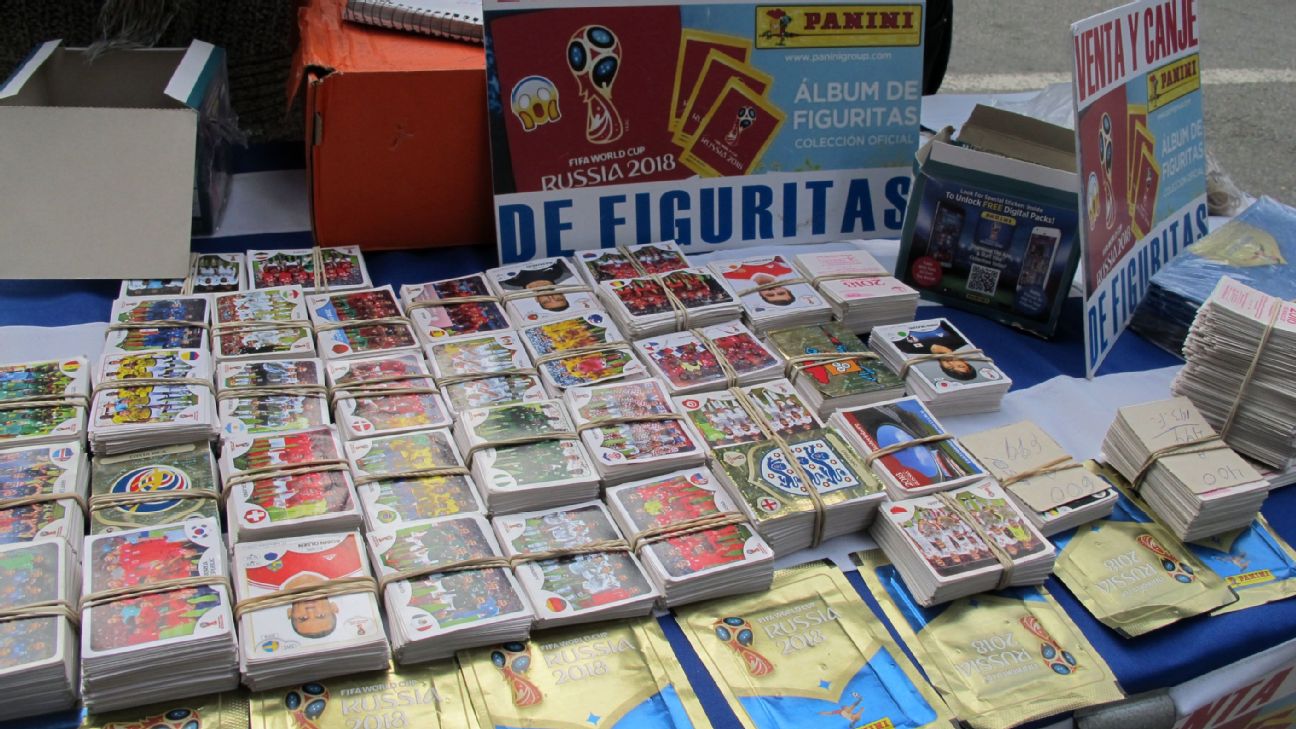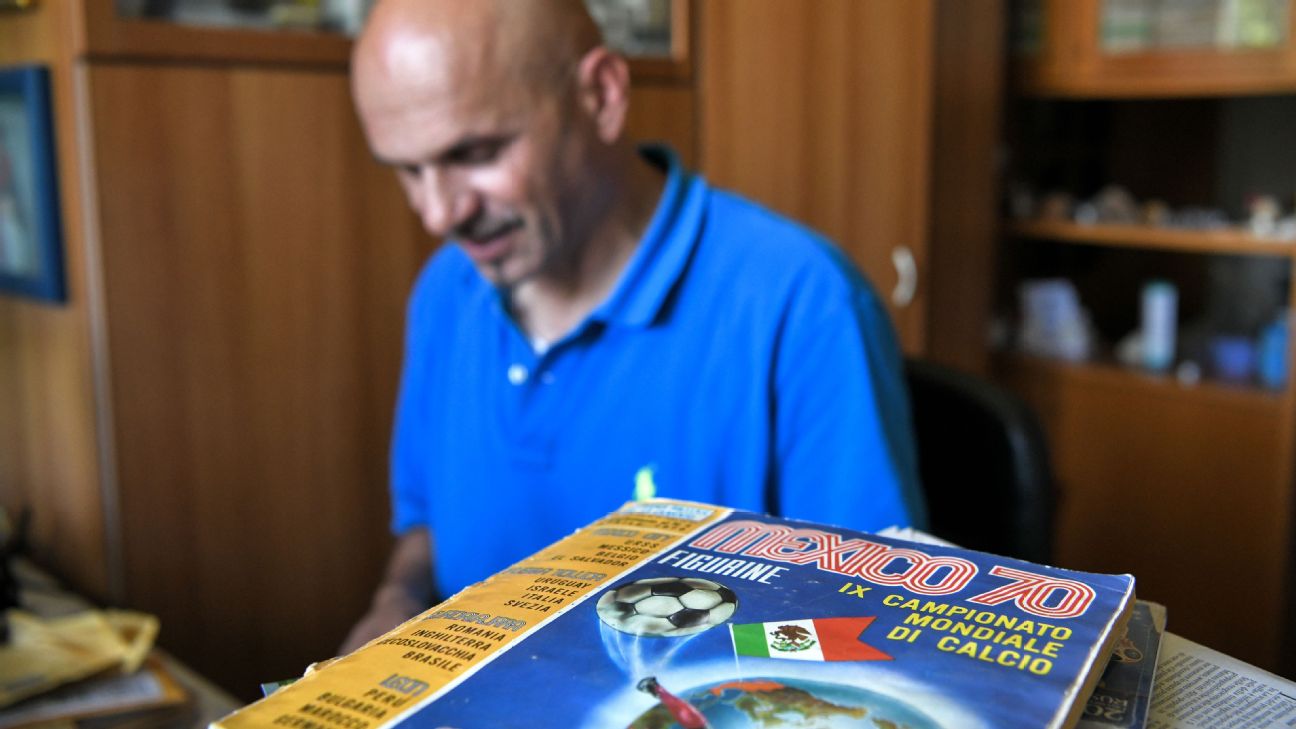Products You May Like




MEXICO CITY — Got, got, got, need, got, need. Those two words in a random loop conjure up certain feelings for Panini sticker collectors, especially when it comes to World Cups. That sensation of being an excited child (or adult) counting down the days and minutes for the tournament to kick off, pile of stickers in hand, negotiating your “swaps” as if your life depended on it in order to fill out your album, strikes a chord with many.
– ESPN+: Stream ESPN FC TV daily
– ESPN 30 for 30: ‘Mysteries of the Jules Rimet Trophy’
– ESPN: The colors and innovations of the 1970 World Cup
World Cup sticker collecting through the years has become a pre-tournament ritual now shared across over 120 countries and has included the likes of Ed Sheeran, Kobe Bryant, Gianluigi Buffon and even prominent politicians. The thrill of buying a pack of stickers, finding a much sought-after player and perhaps bringing the stars of the game that little bit closer to home stretches back to that very first Panini World Cup album 50 years ago: Mexico 1970.
A kids’ craze becomes a family heirloom
Emilio Lopez remembers the task of completing that original 1970 album vividly.
In the Mexico City neighborhood of Mixcoac, Lopez was among the first wave of those caught up in the Panini craze, desperately trying to accumulate the stickers needed to complete his album. Pele, Franz Beckenbauer, Bobby Moore and Mexican striker Enrique Borja were all hard to find in exactly the same way that Lionel Messi, Cristiano Ronaldo or Mohamed Salah are today.
The 1970 album cost around two Mexican pesos at the time, remembers Lopez, with a pack of five stickers around 20 or 25 cents, which was still substantial for a 10-year-old saving up his pocket money to buy the stickers and cards (the 1970 World Cup album was a mix).
Fast-forward to Russia 2018 and a Cardiff University study estimated it would cost around $1,000 to find all 682 stickers for the album and complete it only by buying packs of stickers (at a cost of close to $1 for five stickers).
In 1970, just like today, there were always ways to cut costs.
“We flipped a coin in the air and that was how we did it to fill the album quicker, it was the most economical way,” said Lopez. The coin flicks to decide the fate of piles of “swaps,” or exchanging multiple stickers for a badly needed one, were early tricks people used to fill their albums in Mexico.
The Mixcoac method Lopez used is not too different from today, although websites like LastSticker and SwapStick that have popped up to cater to global “swaps” make things easier, as did the #gotgotneed hashtag on social media for Russia 2018.
“Adults no longer have the school playground, but the cyber-playground provides a far greater number of potential swappers, all around the world,” said Greg Lansdowne, author of “Stuck on You: The Rise & Fall … & Rise of Panini Stickers.”
Lopez knows the value of the album he collected in 1970 has gone up many times in the 50 years since those schoolyard days — it could be worth over $2,700 depending on the condition, according to Wouter Waaijer, a Dutch sports memorabilia expert at online auctioning outlet Catawiki — but it’s now in the possession of his son Fernando (note: Fernando is an editor for ESPN Deportes) and Lopez won’t consider selling.
“It has a very, very sentimental value,” said Lopez.
No signs of slowing down
The 1970 album itself was slightly different to the ones that we’ve become accustomed to in recent editions, although the resemblance isn’t far off considering it’s been half a century since it was designed.
“One of the attractions of Panini, especially to investor collectors, is the consistency and standardisation of the albums over the years,” said Lansdowne. “By and large, they have stuck to the traditional head and shoulders images and — even more importantly — retained the licenses for most of the teams featured, to ensure an authenticity to their albums.”
The first page of 50 in the 1970 album is dedicated to the Mexico ’70 World Cup, with the next eight pages containing a brief history of each of the eight FIFA World Cups until that date, with three of the main players from each receiving a card each. Then comes the bulk of the album that will have a familiar feel, with Mexico the first team containing its logo, the players and a team photo.

These days, each of the 32 squads — soon to be 48 in 2026 — gets an even 18 spots for players, but back in 1970 only Mexico, the Soviet Union, Italy, Brazil, England and Germany had 14 player spaces, with the other 10 teams receiving only 11.
Players’ photos were printed on cards that had to be glued onto the album, with around 40 stickers pertaining to the flags, posters and team photos. In total, there were 288 cards and stickers to collect, 394 fewer than there were in the book for Russia 2018.
“Since Munich ’74, they have entirely been made up of stickers,” said Lansdowne. “The first ‘shiny’ badges in a Panini World Cup album didn’t arrive until 1982.”
As Panini heads into its sixth decade of World Cup sticker-making, the collection market is showing few signs of slowing down, with new avenues opening up outside of the men’s World Cup. Waaijers says the 2011 Women’s World Cup album could become what the 1970 World Cup album has become to collectors today.
“To keep a long story short: the popularity of women’s soccer is increasing very fast,” said Waaijers, adding that there are now two more Women’s World Cup editions (2015 and 2019) and that the 2011 edition was only sold in Germany.
The rise of a sporting collectible empire
Panini was founded in 1961 by brothers Giuseppe and Benito Panini in the Italian town of Modena, where the company is still based. The family business started with the Calciatori/Football Players collection, with the brothers branching out from their newspaper distribution company. The stickers soon became more popular than the newspapers.
It hasn’t been a seamless upwards trajectory for Panini, but the multi-national company now claims to be “the world leader in the collectibles and trading cards market,” employing over 1,200 people and reporting a turnover beyond the $1 billion mark over 150 territories in 2018, a World Cup year.

Things could’ve been different had the Panini brothers not taken a risk. Attaining a license from FIFA to launch the three editions (international, Italian and English) for the 1970 album paved the way for the company to become what it is today.
“[The 1970 album] was the launching point so collectors and football fans had a unique, different and fun alternative to have their favorite players in the palm of their hands,” said Francisco Poch of Panini Mexico, who works in marketing collections. “Panini may have produced prints for Calcio, but it was the 1970 World Cup that exposed the brand and the product internationally, where it had a great response and formed the base for upcoming years.”
One final bid leads to record purchase
The Mexico ’70 album has, on first glance, very little in common, either in terms of generation or geography, with 12-year-old Lorenzo Vandelli in Sassuolo, Italy, but that hasn’t stopped him from owning arguably the most cherished version of all.
Lorenzo and his father, Maurizio, were thrilled when they won the bid in 2017 for a completed 1970 World Cup album signed twice by Pele, except for one thing: they hadn’t told anyone else in the family that they were even planning to bid on it. And they’d just broken the record price for a Panini album by splashing out €12,038 ($13,349).
Mexico ’70 Panini album signed by Pele up for auction https://t.co/IpV3Vq0tuU pic.twitter.com/FDQPJoK7Ua
— Matt Barker (@matthew_barker) March 20, 2017
“At that point, our problem wasn’t having won the auction, but having to justify ourselves to my wife and daughter,” Maurizio told ESPN. “Lorenzo said: ‘Don’t worry, Dad. You and me could go and sleep at the hotel!'”
Lorenzo, then aged 9, had managed to convince his father, who runs the family hardware story in Sassuolo, to put one final bid in, but despite the expense, the special Pele-signed album and others from 1970 are expected to increase in value. “My expectation is that the value [of the albums] still will increase,” said Waaijer. “Once collecting has been started, there’s almost no way back!”
The ‘Holy Grail’ of Panini albums
Lorenzo is something of a celebrity in the world of collectors and boasts a collection that includes “many thousands” of stickers, a number of completed albums, a Santos shirt worn by Pele (he’d love to get it signed) and other memorabilia. And he has a special interest in the Brazilian legend, despite the famous 1970 Brazil team defeating Italy 4-1 in the final at Estadio Azteca.
“My classmates say I’m crazy, but when I have the stickers in my hand, it’s a unique feeling!” said Lorenzo.

The auction for the Pele-signed album garnered international media attention — bids came in from 17 different countries — and the album became the world’s most expensive Panini sticker album in history, which was predicted but was something that Catawiki wasn’t 100% prepared for.
“I expected many collectors to want this Holy Grail album, and it was very exciting that the seller trusted our ‘collectors range’ by offering this album without a [minimum price],” said Waaijer. “But I didn’t expect the attention of dozens of international newspapers and television stations, and I could only dream that now, in 2020, it’s still the worldwide most expensive Panini album sold.”
Swap my Pele for your Egwuekwe
Finally, this story couldn’t be written without asking Panini about the 50-year debate that unites (or divides) all the generations of collectors: Does Panini really produce fewer Pele, Johan Cruyff or Cristiano Ronaldo stickers than they do Igor Belanov, Egidio Arevalo or Azubuike Egwuekwe?
“Panini makes the same amount of prints of each player, crest and hologram, whether it be a World Cup or any other collection,” said Poch of Panini Mexico.

Poch argues that the popular players, like Messi, are in higher demand and may be used to stick onto computers, walls and cellphones rather than in the album, making it seem like there are fewer.
“It is the demand that provokes the idea that some players or holograms are more complicated [to get]; it is part of collecting,” he added.
There’s little sign that that particular debate will be settled so easily, but that’s part of the nostalgia and fun of five decades of got, got, need, got, need…
